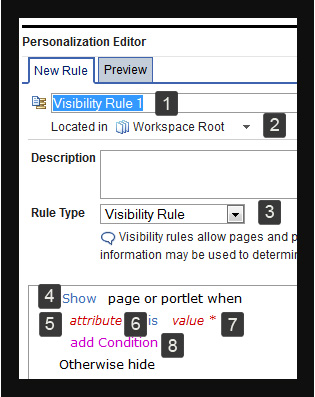Example: Creating a visibility rule that uses the referral host and search attributes | HCL Digital Experience
Learn more about the Referrer application object through an example. In this example, you are creating a visibility rule that uses the referral host and search attributes. These attributes are only used in rules to display ski related vacation information for users that search on ski trips in Google.
About this task
Procedure
- Click .
- From the Personalization Navigator, click .
- For Rule Type, select Visibility Rule.
- The numbered screen capture, along with the corresponding
table, provides the values and selections that are used in this example.
Use these example values and selections to guide you in creating a
visibility rule that uses the referral host and search attributes.

Table 1. Creating a visibility rule that uses the referral host and search attributes for the Referrer application object Numbered item in screen capture Description 1 Type Ski vacation information as the name for your rule. 2 By Located in, use the default folder to store your rule for this example. 3 For Rule Type, select Visibility Rule. 4 Continue to use Show in this example to show a page or portlet that is based on the conditions that you define in this rule. 5 Click . The attribute label changes to current Referrer. Referral Host. Note: The Referral URL attribute is another attribute available to you with the Referrer application object. Use the Referral URL attribute when a user is referred to your site from a search engine other than the supported search engines. Use the Referral Host attribute, as shown in this example, when a user is referred to your site from the supported search engines.6 In this example, continue to use is as the comparison operator. 7 Click value * to enter www.google.com as the value for the condition. Click Submit. 8 Click . The attribute label changes to current Referrer. Search Keywords. Note: You can provide a value for the Referrer. Search Keywords only when a user is arriving to your site from one of the supported search engines.Not shown in screen capture Click value * to enter skiing as the value for the condition. Click Submit. - Click Save.
You successfully created your visibility
rule. You can add your rule to a page or portlet from the Manage Pages
area of your site.
Note: Visibility rules do not hide pages or portlets
for anonymous users.
- To open the Manage Pages portlet, click the Administration menu icon. Then, click .
- Click Content Root.
- Go to the page that you want to use your rule.
For example, you might have a page that is named Ski Vacations in the Home area of your site. To locate the Travel page, click
- After you locate your Travel page,
follow the instructions for adding your rule to a page or for adding
your rule to a specific portlet.
Option Description Instructions for adding your rule to a page - Click Edit Page Properties.
- Expand Advanced options.
- Click the arrow by Show or Hide page rule, and click Select Rule.
- Select the check box by a rule you want to add to your page. Click OK.
- Click Done
Instructions for adding your rule to a portlet - Click Edit Page Layout.
- Make sure that Show portlet rule mapping is enabled. When this option is enabled, you see a Hide Portlet Rule Mappings link.
- Click the arrow by No rule mapped for a portlet on this page, and click Select Rule.
- Select the check box by a rule you want to add to your portlet. Click OK.
- Click Done.